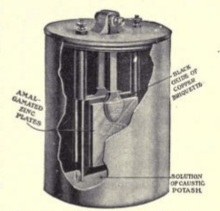Edison–Lalande cell

The Edison–Lalande cell was a type of alkaline primary battery developed by Thomas Edison from an earlier design by Felix Lalande and Georges Chaperon.[1][2] It consisted of plates of copper oxide and zinc in a solution of potassium hydroxide. The cell voltage was low (about 0.75 volts) but the internal resistance was also low so these cells were capable of delivering large currents.[3]
History
Lalande–Chaperon cell
In 1880, the manufacturer De Branville and Company of 25 rue de la Montagne Sainte-Geneviève, Paris exploited the patent of Lalande and Chaperon to build copper oxide batteries.[4] In 1887, the French submarine Gymnote (Q1) was built. The boat was originally fitted with 540 Lalande–Chaperon alkaline cells which used zinc and copper oxide electrodes with potassium hydroxide electrolyte, manufactured by Coumelin, Desmazures and Baillache.
Edison–Lalande cell
Edison improved on the Lalande–Chaperon cell by replacing powdered copper oxide with copper oxide briquettes.
Poerscke–Wedekind cell
Another modification to the Lalande-type cell was patented by Heinrich Poerscke and Gustav Wedekind in 1905, British patent GB190416751.[5] In this cell, the copper oxide depolarizer was pasted on the inside of a cast iron pot. When the depolarizer was exhausted, the cell was dismantled and the liquid was poured out. The pot was then heated in air to re-oxidize the deposited copper to copper oxide. The Neotherm cell, by Siemens, was similar.[6][7]
Chemistry
The zinc dissolves in the hydroxide solution to form zincate, consuming hydroxide in the process.
Zn0 + 4OH− -> [Zn(OH4)]2− + 2e−
half of the hydroxides are replenished by the hydration and reduction of the copper oxide.
CuO + H2O + 2e− -> Cu0 + 2OH−
Applications
Applications for Lalande-type batteries included submarine power (see above), railway signalling.[8] and powering Edison's electric fans and phonographs.[9]
References
- ↑ "Location Text and List of Documents – The Edison Papers". Edison.rutgers.edu. Retrieved 2013-06-12.
- ↑ "Storage Battery – The Edison Papers". Edison.rutgers.edu. 20 February 2012. Retrieved 2013-06-12.
- ↑ Ayrton, W.E. and Mather, T. Practical Electricity, Cassell and Company, London, 1911, pp 196–197
- ↑ "Les Piles Lalande et Chaperon". Dspt.perso.sfr.fr. Retrieved 2013-06-12.
- ↑ "Espacenet – Bibliographic data". Worldwide.espacenet.com. Retrieved 2013-06-12.
- ↑ https://archive.org/stream/electricaljourna63lond/electricaljourna63lond_djvu.txt
- ↑ http://www.ebooksread.com/authors-eng/arthur-john-allmand/the-principles-of-applied-electrochemistry-hci/page-20-the-principles-of-applied-electrochemistry-hci.shtml
- ↑ "A Short History of Ancient Electricity". Bibliotecapleyades.net. Retrieved 2013-06-12.
- ↑ "Edison Type S Battery Set". Edisontinfoil.com. Retrieved 2013-06-12.
